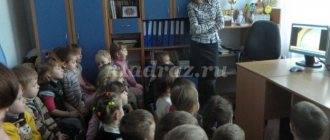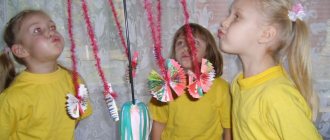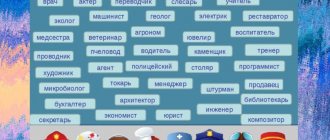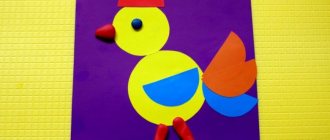MAGAZINE Preschooler.RF
Passport of the pedagogical project in the second junior group No. 2 “FIREFLIES” “The magic of didactic games”Municipal budgetary preschool educational institution of the Pushkin municipal district. Kindergarten No. 12 “Cornflower”
Prepared and conducted by educators:
- Serkova A.A.
- Biricheva O.A.
Zelenogradsky village 2022
Project passport
Project name: “The Magic of Didactic Games”
Type of project: group, educational, gaming, creative.
Project duration: long-term (February to May)
Age group: second youngest
Project participants: group children, parents, teachers.
Relevance of the project:
Modern children live in an incomparably wider information environment than their peers ten years ago, so a modern child is bombarded with a huge flow of information, which creates the task of teaching children to cope with it, analyze and process the incoming amount of knowledge.
The priority task of the Federal State Educational Standard for Education is the formation and development of the child’s intellectual abilities, as well as creative potential, with the creation of conditions for children’s development, personal development, positive socialization, based on cooperation with peers and adults.
During the period of early preschool age, knowledge is accumulated at a fairly rapid pace, cognitive processes are improved, speech is formed, and children begin to master simple methods of mental activity. For this reason, the relevance of developing children’s abilities in early preschool age is of great importance for the child’s future activities.
When constructing an educational impact, it is important to take into account the child’s leading activity, and the leading activity of a child of primary preschool age is play. More classics of Russian pedagogy K.D. Ushinsky, A.S. Makarenko, V.A. Sukhomlinsky, in his theoretical works and practical experience, devoted a special place to the game, noting its beneficial educational, training and developmental capabilities and pointed out the need for games for preschoolers. A special place among the various games of preschool children is occupied by a didactic game. Didactic games are a type of games with rules, specifically
created by pedagogy for the purpose of raising and teaching children. These games
are aimed at solving specific problems of teaching children, but at the same time
They manifest the educational and developmental influence of gaming activities. They are a gaming method of teaching preschool children, a form of education, an independent gaming activity, and a means of comprehensive education of a child’s personality. Research by psychologists has shown that during the game, even an intellectually passive child is able to complete a volume of educational work that is completely inaccessible to him in the educational process.
The children in our group showed contrast in terms of general development.
Some lag behind their peers due to frequent illnesses, there are children who receive little attention from adults at home and children who do not show interest in the new, unknown. We believe that in the current circumstances, the systematic use of didactic games in work will contribute to the development of mental abilities, speech potential, cognitive activity and communication abilities of children in our group.
Project goal: Using didactic games to develop mental abilities, speech development, communication skills, cognitive abilities and cognitive activity of children of the second junior group.
Project objectives:
- To study material on the topic of the potential of didactic games in the formation of the intellectual abilities of younger preschoolers.
- To develop children's interest and ability to play didactic, board and printed games with children.
- In the process of games, develop in children interest in the environment, observation, speech, and enrich their vocabulary;
- To help parents create conditions for didactic games with children at home and expand knowledge on managing play activities.
- Enrich the subject-developmental environment of the group with didactic games and toys.
- Activate and enrich the educational skills of parents, maintain their confidence in their own teaching capabilities.
Project implementation stages:
Stage 1 - preparatory stage (February)
Stage objectives:
- Study of modern requirements for the content and organization of work on the development of mental abilities of children of primary preschool age in accordance with the Federal State Educational Standard.
- Development of consultations for parents about the educational and educational potential of didactic games.
- Development of the content of the project “The Magic of Didactic Games”
- Selection of methods and diagnostics of children to identify the level of development of various skills.
- Selection of didactic games for all educational areas of the program.
- Selection of materials for the production of didactic games and manuals for working with children
Stage 2 - main (March - April)
Stage objectives:
- Conducting a parent meeting on the topic.
- Selection and production of didactic games and visual aids.
- Involving parents in the production of didactic games and aids for children's development
- Introduction of educational didactic games into all routine moments of working with children.
- Conducting individual work with children.
Stage 3: - final (May)
Stage objectives:
- Creation of card files of didactic games and exercises in all educational areas of children's development.
- Creating a project presentation on the work done.
- Monitoring children's development.
- Analysis of the results obtained, conclusions.
Results of diagnostics of children at the beginning of project activities
When compiling these lessons, we relied on the following principles:
- Unity of cooperation between children, teachers and parents, the use of means and methods that will ensure an understanding that the subject of interaction is a child, as well as his characteristics, needs and interests;
- Consistency and systematicity, during which we used a variety of ways to implement planned classes, and solved problems not only in educational activities, but also during the implementation of routine moments;
- Visualization, namely improving the subject-development environment and using types of visualization for children;
- Accessibility, that is, taking into account the needs, age characteristics of children, as well as their zone of proximal development;
- Connection with real life.
The main part of the classes was designed to work with a group, but some games and exercises were carried out with children individually.
Each game began with the teacher explaining what the children had to do. Some tasks for a more complete understanding by children were initially visually performed by an adult, while he accompanied the implementation with detailed explanations, and then the children completed the next task together with an adult, and then independently.
Project results:
- Thanks to the systematic use of didactic games in educational work, the children of the group improved their indicators: in the development of thinking, perception, attention, memory; the ability to imagine has increased; increased interest in classes;
The speech and physical activity of children in various types of activities improved.
- Children more often use educational board games on their own and play them with great interest.
- Parents are interested in this topic, received new and useful information, and actively use educational games at home with their children.
- The subject-development environment of the group is enriched with didactic games and toys made by parents and educators.
- Card indexes of didactic games were made in all areas of children's development.
- A presentation of the project was held for parents and colleagues of the preschool educational institution.
- “Developing by Playing”, joint with parents
Bibliography:
- Blecher, F.N. Didactic games and didactic materials [Text]: (Number, size, shape, space and time): For preschool teachers / F. N. Blekher. M.: Book on demand, (type T-1). 2010- 160 p.
- Bondarenko A.K. “Didactic games in kindergarten” - M., 1991.
- Kolbina, A.V. Didactic games as a means of developing the intellectual and creative potential of children 2-7 years old: educational and methodological manual / - Ufa: Belaya Reka, 2007. - 39 p.
- Matsaeva V.A. Development of intellectual abilities of preschool children through didactic games. Materials from the site “Journal Educator”. https://zhurnalpedagog. ru
- Novoselova S.L. Preschooler's game - M., 2009.
- Panova E.N. "Didactic games-activities in preschool educational institutions" . Younger age. 2007.
- Sorokina A.I. “Didactic games in kindergarten” - M., 1998.
- Smirnova E.I. Modern preschooler . ” Preschool education. 2002. - No. 4. — P. 70 – 74
- Trofimenko Yu. V. Organization of didactic play activities of preschoolers in the formation of counting skills // Questions of preschool pedagogy. - 2016. - No. 3. — P. 98-103
- Federal state educational standard for preschool education. [Electronic resource] – Access mode: https://Ministry of Education and Science.rf/news/3447/file/2280/13. 06. 14-FGOS-DO. pdf
- Yusupov V.B. Didactic ideas of Ya. A. Komensky in modern educational conditions // KPZh. 2014. No. 2 (103).
- Yankina N.V., Iresheva O.A. The use of didactic games when working with preschoolers // Young scientist. - 2015. - No. 20. - pp. 511-514.
- Internet resources: http: //nsportal. ru/sites/default/files/2014/10/18/opyt_work.
docx
14. Internet resources: https://www. maam. ru/detskijsad/otch-t-po-teme-samobrazovanija-poznavatelnoe-razvitie-doshkolnika-cherez-didakticheskie-igry. html.
| Next > |
“Project activities with children of primary preschool age”
“Project activities with children of primary preschool age”
From birth, a child is a discoverer, an explorer of the world that surrounds him, everything is new for him: sun and rain, fear and joy... everyone knows that little children are called “whys.” A child cannot find the answer to all his questions on his own, and therefore teachers help him with this. Educators are faced with the task already in early preschool age to establish positions of independence, activity, initiative in finding answers to questions, systematize information, and use the acquired knowledge, skills and abilities in games and practical activities. Design technology provides this opportunity
, which allows you to expand the educational space, give it new forms, and provide the opportunity for the development of the child’s creative, cognitive thinking.
Project activities
– this is a children’s initiative, a specific creative activity, a step-by-step movement towards a goal; this is a method of organized development of the environment by a child; This is a link in the education system. Currently, the project method, even in early preschool age, is relevant and very effective. It gives the child the opportunity to experiment, synthesize acquired knowledge, develop creativity and communication skills. My children and I very often engage in project activities on various topics and participate in competitions with them. The children have a lot of fun.
Project activity as a variant of an integrated method of teaching preschoolers, as a way of organizing the pedagogical process, based on the interaction of teacher and student, as a step-by-step practical activity to achieve the goal.
The project method is understood as a set of educational and cognitive techniques that allow solving a particular problem as a result of independent actions by students with the obligatory presentation of these results. The essence of the project method is to stimulate children's interest in certain problems that require possession of a certain amount of knowledge, and through project activities that involve solving one or a number of problems, show the practical application of the acquired knowledge. Thus, project activity is a special type of intellectual and creative activity. This or that activity; a way to achieve a didactic goal through a detailed development of a problem (a technology that should result in a very real, tangible practical result, formalized in one way or another.
In preschool education, the project method is considered as one of the integration options (integration of educational areas based on a single project). The use of the project method in teaching children is a preparatory stage for its further implementation at the next stage of education. A feature of project activities in the preschool education system is that the child cannot yet independently find contradictions in the environment, formulate a problem, or determine a goal (intention). Therefore, in the educational process of a preschool educational institution, project activities are in the nature of cooperation, in which children and teachers of the preschool educational institution take part, and parents and other family members are also involved. Parents can not only be sources of information, real help and support for the child and teacher in the process of working on the project, but also become direct participants in the educational process, enrich their teaching experience, experience a sense of ownership and satisfaction from their successes and the successes of the child. The main goal of the project method is the development of a free creative personality, which is determined by the developmental tasks and tasks of children's research activities. The tasks of research activities are specific for each age. Thus, when working with children of primary preschool age, teachers use hints and leading questions. And we provide children of older preschool age with more independence. Choosing a topic is the teacher’s first step in working on a project. The second step is thematic planning on the selected issue for the week, which takes into account all types of children's activities. At the stage of developing the content of directly organized educational activities, games, walks, observations and other activities related to the topic of the project, educators pay special attention to organizing the environment in the group. We understand that the environment should be a backdrop for heuristic, search activities and develop curiosity in a preschooler. When the basic conditions for working on the project have been prepared (planning, environment), the joint work of the teacher and children begins.
Stage I of project development - goal setting: in younger groups, the choice of project is made by the teacher, based on the interests of the children or diagnostic data.
Stage II of work on the project is the development of a joint action plan to achieve the goal. First, a general discussion is held so that the children find out what they already know about a certain subject or phenomenon. Then the teacher asks the second question: “What do we want to know?” It is important here to show patience, respect for the point of view of each child, and tactfulness in relation to the ridiculous statements of children. When all the children have spoken, we ask: “How can we find answers to the questions?” When answering this question, children rely on their personal experience. It is also necessary to take into account the age characteristics of the students. For children of primary preschool age, the teacher can use hints and leading questions. The solution to this question can be various activities: reading books, encyclopedias, contacting parents, specialists, conducting experiments, thematic excursions. The proposals received are additions and changes to the teacher’s already prepared thematic plan. It is important that the teacher shows flexibility in planning, manages to subordinate his plan to the interests and opinions of children, including children's activities in the curriculum, sacrificing some planned forms of work.
After drawing up a joint action plan, the third stage of work on the project begins - its practical part. Children explore, experiment, search, create. To activate children's thinking, we suggest solving problem situations and puzzles, thereby developing an inquisitive mind. It is necessary to create a situation where the child must learn something on his own, guess, try, invent something. The environment around the child should be, as it were, unfinished, unfinished. A special role in this case is played by corners on cognitive and practical activities.
The final stage of work on the project is the presentation of the project. The presentation can take various forms depending on the age of the children.
Projects, regardless of type, creative, research, informational, open, playful, practice-oriented, etc., require constant attention, help and accompaniment from adults at every stage of implementation. The specificity of using the project method in preschool practice is that adults need to “guide” the child, help detect a problem or even provoke its occurrence, arouse interest in it and “draw” children into a joint project, without overdoing it with parental care and help.
Participation in project activities for children is a way to satisfy cognitive activity, a means of expressing and developing creative abilities. Joint project activities help parents master some pedagogical techniques necessary in family education; objectively assess the capabilities of your children and cooperate with them as equal partners.
Project activities, based on a person-oriented approach to training and education, should ultimately contribute to the development of individual creative activity of teachers in the development of strategy, tactics and technology of the educational process, promote the personal development of students, and ensure high-quality results of teaching activities. This method affects not only and not so much the intellectual sphere of children, but also feelings, emotions, attitudes towards the world around them, and their value orientations. An atmosphere of trust is created in which children feel quite safe and can think freely and express their opinions.
. The project method in working with preschoolers today is an optimal, innovative and promising method that should take its rightful place in the preschool education system.
Get text





